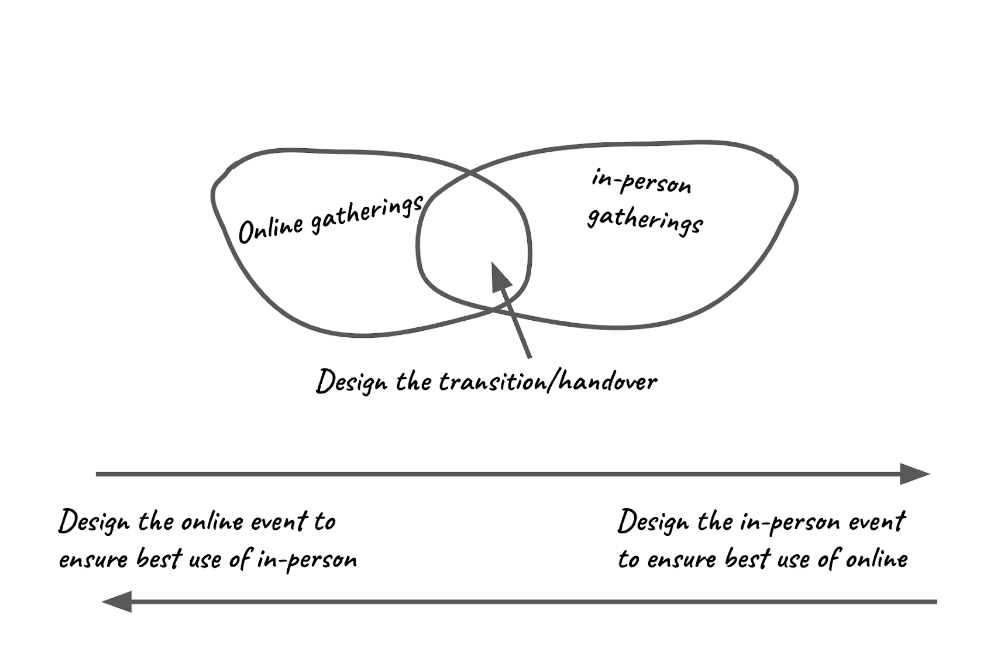It’s about time.
When I think about hybrid events I immediately make an assumption – we’ll have a group of people in a room together and others joining us remotely on a screen. This prompts a long list of ‘how?’ questions.
We ran a hybrid event recently which prompted a different question – when? When can and should we bring people together? It took about four weeks and we didn’t think of it as hybrid until half way through.
Sometimes you just have to get people together at the same time – that’s co-production right? Learning from each other, working together, hearing each others’ stories. But what if, as facilitators, we can weave these together in different ways at different times?
Maybe the challenge of a successful hybrid meeting is synchronising but we create gatherings and maybe online and in-person gatherings don’t have to happen at the same time.
A recent project led to us working with a city-wide group of ‘professionals’ and also with some small community groups based in particular locations around the city.
Each of these had an important part to play in designing a new process. Their contexts were very different so we chose an online gathering for professionals and planned for some in-person community discussions afterwards.
It worked well. The professional group was given time and space to discuss internal processes as well as helping us to consider how we work with local citizens.
We then used the outputs from this to design our in-person community conversations which took place two or three weeks later, in venues and at times that suited our participants. Our associates were accompanied by representatives from the professional group.
We had planned the conversations carefully, ensuring inclusion and respect, converting our online process into physical materials, and they were a success.
A few key points:
- An online workshop suited a large, professional group with other major time commitments
- our meetings with existing community groups were in their space and they supported each other to share experiences
- We were able to tailor activities and timescales to each group
- In-person conversations can be more exploratory and social whereas online activities can be more focussed
- There’s a new part in the process to think about – the handover from online to in-person.
So a new question for us is this: if we were asked to run an event that is assumed to be simultaneously online and in-person, would we consider doing them separately? Of course, the answer is ‘it depends’, but it’s a new event design consideration.
And the handover? We had time after the online event to analyse and reflect and consider how we would change our original ideas for in-person discussions. There was a new creative space in between.

We shaped an in-person process, possibly more intentionally than before, because of the outcomes from the online event. We were able to use our time with community groups more effectively – this is important, it’s a valuable resource.
Our process felt right. We ended up providing the best environment and experience for each group, collecting similar and complementary data and sharing stories between groups.
This won’t work every time but it makes us consider more carefully:
- What type of gathering is this?
- What are we trying to do and why?
- What’s appropriate for participants? What will give them the best experience of interacting with the organisation?
- How can we translate digital tools and processes into the real world?!
- While we’re aiming to offer the best of both worlds, will we end up providing a compromised version of each by offering them at the same time?
Seth Godin writes about mixing things up to create a hybrid:
“The goal is to find something that is in and of itself. That becomes the very best version of what you’re trying to do, the solution to the consumer/user/member problem you’ve identified. Here works. There works. But here and there and everywhere generally doesn’t. In a world filled with choices, specificity in service of extraordinary results tends to outperform.”
While there is much hybrid talk about ‘how’ – the technology to use, how to arrange the seats and when to use the chat – perhaps we need to consider the ‘why’ and ‘when’ a little more often.
